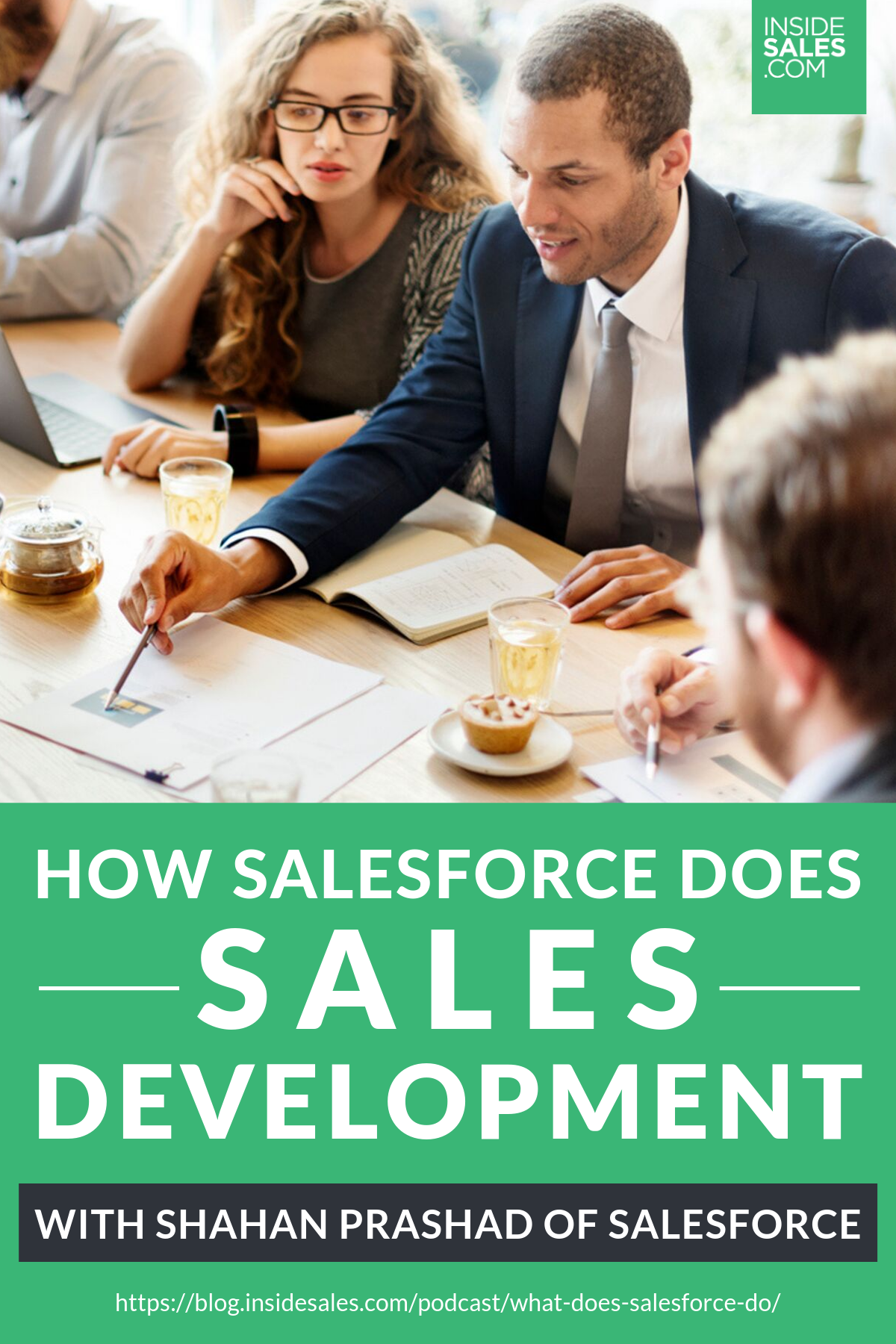How Salesforce Does Sales Development w/Shahan Prashad @Salesforce
What does Salesforce do to manage their Sales Development team? Read on to learn all about it from Salesforce’s VP of Sales Development himself, Shahan Prashad.
RELATED: Five Sales Development Plays to Nail in 2019 w/Dann Gottlieb @TOPO
In this article:
- The Salesforce Sales Development Team Organization
- What Does Salesforce Do Through Its SDR Team?
- What Does Salesforce Do When It Comes to the SDR-BDR Handoff?
- How Many Leads Does the Salesforce SDR Team Cover?
- What Does Salesforce Do: The Sales Development Process
- Why Speed Matters in the Customer Relationship Management Process
- How Does the Salesforce SDR Team Work with the Marketing Team?
- What Does Salesforce Do When It Comes to SDR Compensation?
- Why Having a Generalist SDR Team Is Better
- What Does Salesforce Do to Innovate?
What Does Salesforce Do to Manage Their Sales Dev Team?
What Is Salesforce? Salesforce provides customer relationship management (CRM) solutions to bring companies closer to their customers. They offer an integrated CRM platform that gives each department a streamlined view of the company’s customers.
We invited Shahan Prashad, Vice President of Sales Development at Salesforce, to share with us their best practices on sales development.
Prashad is originally from Toronto, Canada, and he moved to the U.S. 15 years ago. He worked as a management consultant before joining Salesforce seven years ago.
He started out in the Sales Strategy and Operations team where he learned the inner workings of a sales business. Two years ago, he transferred to what he described as his “dream job.”
Prashad began to lead Salesforce’s North American SDR organization. Their team qualifies all the inbound interests that come through their website.
He leads a large organization of 150 sales development reps and globally, Salesforce has an even larger organization. As Prashad said, having this many SDRs is critical to their success, as it represents a lot of their new business generation.
The Salesforce Sales Development Team Organization
Prashad began by giving us a background on how Salesforce organizes their sales business. They have three macro segments:
- Enterprise
- Commercial
- SMB
Within those three, they also have sub-segments based on the geography they belong to and work on. Overall, their sales development organization aims to support these businesses.
Salesforce’s Sales Development has two roles. They have the sales development reps, the team of which Prashad leads.
This team is also called the inbound qualification team. They qualify all inbound phone calls, chat inquiries, and web traffic that comes from the form on their website.
The majority of what Prashad’s team works on falls on the SMB segment.
After a year, they promote their SDRs to the other sales development role, the business development rep. This team is also known as the outbound cold calling team, and they typically work in the commercial and enterprise segments.
Prashad explained that although their SDRs serve all the macro segments, they still follow rules of engagement. For instance, if a lead comes in and it’s more efficient for a BDR to handle it, they’ll pass that account.
As of our discussion with Prashad, Salesforce has twice as many BDRs as there are SDRs.
What Does Salesforce Do Through Its SDR Team?
Now that we have a clear understanding of their structure, what does Salesforce do through their large SDR team? Prashad shared with us their workflow map.
Their SDR organization primarily works on five different types of leads. The first two are what they call the “live channels,” which are the 1-800 numbers and their website chat.
Calls and website inquiries go directly to their SDRs and they’re the ones who respond. These leads flow through their marketing automation system.
Prashad said that they themselves use Salesforce Marketing Cloud for their marketing automation.
It uses the leads to make sure that there is only one lead marker for people who come in multiple times. Their marketing automation system also implements their rules of engagement.
Prashad admitted that their rules can get a little complex, so having an automation system implement those are very helpful to them. Their reps still do one last manual check before working on a lead because, as Prashad said, the automation isn’t perfect.
What Does Salesforce Do When It Comes to the SDR-BDR Handoff?

Creating and encouraging good sales handoffs to maximize sales success
Does Salesforce have complex routing rules? Prashad said the complexity depends on the market.
Some of their markets have a more complex structure than others. To cater to that, they have multiple BDR teams that specialize in certain products or segments.
For example, they have a BDR team dedicated to prospecting for their Marketing Cloud solution. If a lead comes in and it’s a marketing person, they send it to the dedicated BDR.
If the lead has nothing to do with marketing, their SDRs send it to another BDR. There are nuances to how Salesforce does routing and having a technology to aid them makes the process more efficient.
How Many Leads Does the Salesforce SDR Team Cover?
Prashad disclosed that the amount of workable leads in a year that his team works on is roughly a million. That huge volume is only what his team can work on, and it doesn’t cover yet what their BDR teams actually work on.
Their scale is large, so what does Salesforce do to cover all those leads?
Prashad said that it’s precisely for this reason why they have a large organization of 150 SDRs. These reps put in millions of calls into their leads to set 100,000 meetings.
What Does Salesforce Do: The Sales Development Process
Since they have roughly a million leads, we asked Prashad, what Salesforce does to cover all those.
He explained to us the process they follow for Sales Development. First, they worked out service-level agreements (SLAs) with the business.
These determine how much effort they put in and how they staff their organization. They established two SLAs:
- Persistence — The number of times they’ll call a lead back
- Speed to the first call
When it comes to persistence, Prashad shared that, in general, they call back every lead five times. Aside from calling, they also send emails.
After that cadence, if they don’t contact the lead anymore, it will join the marketing nurture journey.
Yet as they work smart, Prashad said that not all leads get only five calls. Some reps decide to call a lead seven to eight times if they feel it will yield a good result.
Salesforce hired a team of industrial engineers from the University of Toronto to mine their CRM data and replicate existing studies. They arrived at the optimal number of five calls per lead after tailoring studies for Salesforce and weighing factors like ROI.
Why Speed Matters in the Customer Relationship Management Process

Teaching SDR’s how to quickly and efficiently contact leads for better sales
It was no surprise to Prashad and his team to learn that speed really matters to their customer relationship management process. They found an exponential decrease in connect rates for every five minutes they waited before calling back an inbound lead.
They took this finding to heart, so they transformed their organization to gear it for and optimize around speed. This meant making sure their systems are able to quickly transfer leads to the SDRs, ensuring that the reps understood the importance of speed, and making sure they hire staff accordingly.
Prashad shared that sometimes, they would take on a little bit more headcount than they need. Yet, it’s worth it for them to ensure they have very fast SLAs.
They also ensure they prepare their tracking and measurements, and engineer the entire process seamlessly.
How Does the Salesforce SDR Team Work with the Marketing Team?
Salesforce’s SDR and Marketing teams work with the guiding principle that they’re partners in everything. They have the same key performance indicators (KPIs).
At Salesforce, about a third of the new business pipeline comes from the SDR or BDR organization.
For their individual SDRs, they track a lot of metrics. These include the following:
- Calls
- Meetings
- Sales qualified opportunities
- Bookings that come from the SDR channel
Their SDRs have a booking quota, which is the annual contract value (ACV) quota. The aggregation of their ACV quotas is the number that both the SDR and Marketing teams are accountable for.
Sales, Sales Development, and Marketing are all 100% aligned with each other in terms of metrics.
RELATED: How to Create a Winning Culture
What Does Salesforce Do When It Comes to SDR Compensation?
Prashad said they pay their reps based on the ACV they generate. They have a variable compensation plan, and the variable component here is the ACV.
Prashad clarified that they also understand the SDRs cannot control everything when it comes to the ACV they produce. Yet after studying this and going through different models over the course of 15 years, they believe that paying their inbound organization based on ACV is the right thing.
This aligns their incentive. It also makes sure they’re generating and passing off quality leads to the sales team.
Prashad acknowledged that this compensation system isn’t always applicable. An example of such a case is an environment where reps have a really long sales cycle, like two to six months.
Yet in Salesforce, the sales cycles are short — they run between two to five weeks so reps can really see the impact sooner.
Why Having a Generalist SDR Team Is Better

Creating a diverse, generalistic team of professional SDRs for great sales
Salesforce firmly believes that a generalist SDR model is the right model. This is also how they structured their organization and roles.
A lot of organizations think about having specialized SDRs by industry or by market segment. Yet what Salesforce learned is that, at least for the scale of their inbound organization, generalization certainly trumps specialization.
Prashad enumerated the reasons why having a generalist SDR team is more beneficial:
1. You Can Pull All Your Capacities Together
Prashad said that once you generalize your SDRs, you can pull all your capacities together and maximize your speed SLA. Whether you have 10 or 140 reps, no matter when a lead comes in, anyone can take it.
2. It’s Easier to Handle Complex Processes
The complexity of your organization’s processes also have implications on your SDR team. One of them is that your systems need to be able to handle complexity.
The more complex your processes are, the higher the risk of having leads fall through the cracks. Your sales reps might also be unable to follow through with leads.
When you have a generalized model, though, it’s easier to handle complex processes. This is because everything just goes to one pool.
3. Your Sales Reps Can Cross-Sell
A big company like Salesforce offers multiple solutions for their customers. By having a generalized team that’s not product-specific, your sales reps can cross-sell.
If you trained your team on every product, they can offer the best solutions and cross-sell or upsell customers.
4. It Allows You to Create a Uniform Accountability Model
By generalizing the teams, Salesforce was able to create a uniform accountability model. This ensures that everyone in the team has equal opportunities.
Every Manager and SDR have an equal quota. Prashad said that you can only do this if each SDR is getting the same type and quantity of leads, which you can achieve through generalization.
Giving everyone the same job and the same leads allowed Salesforce to scale their accountability. More than that, having a uniform accountability model allowed them to see where the differences lie.
Salesforce’s goal is to have identical teams, and that is why they went for a generalist setup. The only specialization they have are time zone and geography.
What Does Salesforce Do to Innovate?
Even though they’re already established, Salesforce still continues to push the boundaries on innovation. Prashad shared that they have three areas of concentration for growth:
- Talent — They aim to find the best, most diverse talent and talent from untapped sources. Then, they quickly onboard their people and push them to produce their quotas.
- Technology — Salesforce finds ways to optimize their new or existing tools better.
- Operational Efficiency — Every year, they find ten percentage points of growth in operational efficiency through 10 different initiatives. These are initiatives they can improve and control.
Prashad shared his excitement for others going through their Sales Development journey. He advises on throwing yourself into the community and connecting with different professionals.
Learning from the example of Salesforce can help you improve your own sales development processes. They employ tried and tested practices and are not afraid of innovating, which is why they’re one of the most established CRM providers.
The next time you want to implement changes to your own SDR team, it may be helpful to ask, “What does Salesforce do?” By looking at the example they’ve set, you can learn the best practices and avoid committing the same mistakes.
What new things did you learn about SDR processes? Share them with us in the comments section below!
Up Next:
- Sales Development Action Plan for 2019
- 5 Life Lessons for the Entry Level Sales Professional
- Three Steps for Breaking Through the Fear and Doing the Hard Things

